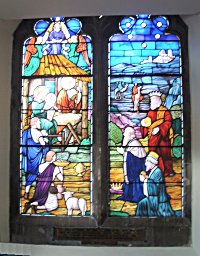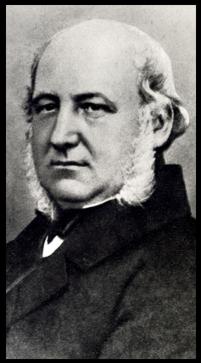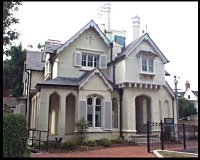Location
In the west wall of the church office

Portrait

Swiss Cottage, Kent Road

CATHERINE OWEN MAY 21 1865
Further Information
Thomas Ellis Owen's parents, Jacob and Mary, probably met when Jacob Owen left his childhood home in North Wales to take up an apprenticeship with Mary's father, William Underhill, who was the resident engineer working on the extension of the Dudley canal to the Worcester and Birmingham canal at Selly Oak. They married in 1798 and Thomas was born on 11 March 1805 in London, Middlesex. He was the fourth of their thirteen surviving children.
When Thomas was only a few months old, Jacob started work in Portsmouth for the Royal Engineer's Ordnance Department, and was eventually promoted to Clerk of Works. In 1832, Jacob, Mary and many of TEO's siblings moved to Dublin. By the time he retired 24 years later, Jacob had become the Architect and Principal Engineer to the Board of Public Works. He eventually returned to live at Park Mount in Kent Road, Southsea, three years before his death in 1870; Mary had died during their time in Dublin.
In keeping with the customs of the day, Thomas, now commonly referred to as TEO, had an eclectic training. It would have included architecture, land surveying and valuation. We also know he "commenced his course by being actually employed in a carpenter's shop for a most respectable and extensive builder expressly with a view of obtaining a practical acquaintance with his business..."; architecture was, however, his chosen path although at times he turned his hand to other ventures.
TEO's career began early and his capacity for hard work was in evidence from the beginning. At the age of 21 he was Clerk of Works on the site of All Saint's Church, designed by his father, in Commercial Road. During that time he was, however, also working for Robert Cruikshank, designing the villas and crescent that made Alverstoke (in Gosport) the 'favourite resort for those who appreciate the union of the most delightful marine and rural scenery'. Most of TEO's work was centred around Portsmouth and Hampshire, apart from a few churches, parsonages and schools in other parts of the country. His main legacy, however, can be found in the villas, terraces and curvy lanes bedecked with foliage that are still apparent in modern Southsea.
Before this gentleman employed his fortune and energies in the advancement of the future town, the "village", as it was called, was hardly even worthy of that minor appellation. A lonely farmhouse, a single row of small cottages and shops and a few detached dwellings were all that existed, prior to the erection of Portland Terrace.
Over the years he became involved with other ventures though and each of these had the potential to benefit his architectural career. They included building speculation, lease-holding, brick-making, carpentry, land surveying, banking and the provision of gas and water supplies.
TEO also played a part in local politics and was a member of the Reformed Corporation. He had been an active agitator for its reform and in November 1843, was elected to represent St Thomas and St Paul's Wards. He became an Alderman in 1850 and was made Mayor in 1847 and again, just before his death, in 1862. During those years he served as a Magistrate, campaigned to bring the Public Health Act to Portsmouth (albeit unsuccessfully) and worked on many committees, for example the Board of Guardians for St Mary's Workhouse.
[Information courtesy of the Thomas Ellis Owen web site]
See also the memorials in this church to:-
Louisa Anne Byng
Mary Owen
Jeremiah Owen
Lydia Owen
Jacob Owen
